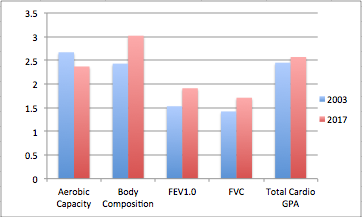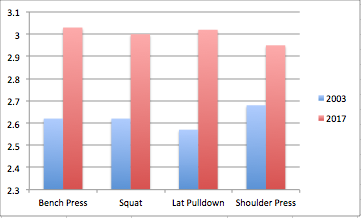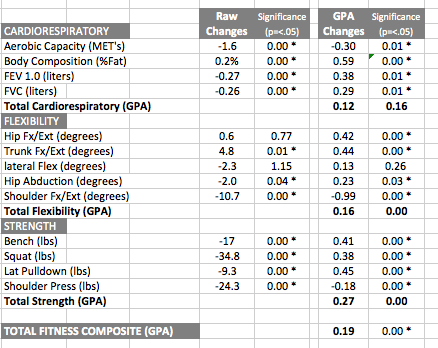Introduction
Three hundred and sixty-two Firefighters from the city of Tacoma were assessed for physical fitness in 2003. A follow up fitness assessment was performed on the 342 firefighters in 2017. This study is to document the changes in the subgroup of 167 firefighters that were assessed using the same testing protocol on both occasions over an average time span of 14.4 years.
Demographics
One hundred and sixty-seven firefighters were assessed, (157 males and 10 females). Initial testing showed an average age of 37.3 years, and average weight of 196.0 lbs, and height of 70.7 inches. Average time between initial physical assessment and final assessment was 14.4 years.
Table 1: The descriptive statistics are shown below

Methods
Firefighters were assessed for 3 major components of fitness: 1) Cardiorespiratory, 2) Flexibility, and 3) Strength.
Cardiorespiratory fitness was performed of a 3-stage protocol for a total of six minutes on a bicycle ergometer using the equation of Von Dobeln (1). The equation was chosen because of the low standards error of estimate of any equation available when combined with allometric scaling algorithms developed by Surina (2).
Aerobic Capacity (METs)=((((1.29*SQRT((Work(watts)*6.12)/(Exercise Heart Rate(b/m)-60)) *EXP((0.00884+(Age(yrs)*0.0000223))*Age(yrs)))/(Weight(lbs)/2.2046))*1002
A bicycle ergometer (Sensormedics Ergoline 800s) was chosen as the instrument of choice because of the consistency of the workloads from trial to trial, regardless of the change in weight of the subjects over time. Subjects were instructed to pedal at 50 RPM and workloads were chosen to allow the firefighter to ensure completion of the protocol and to raise the heart rate beyond 60% of maximum heart rate reserve to ensure a maximal to near maximal stroke volume for extrapolation to estimated maximum values.
Allometric scaling of all maximum oxygen consumption estimates were performed using the following correction factor:

By scaling the oxygen consumption estimates by body dimension, a much more functional value could be assigned to the subjects fitness. All firefighter evaluated was compared to a standard derived from a database of over 23,000 men and women.
Body Composition was performed using a Harpenden skinfold caliper using a total of 12 variables used to predict the subject’s percent body weight and ideal body weight. The method used incorporated the averaging of 9 different skinfold equations, creating a regression equation to match the averaging of the various skinfold equations and using this derived equation to calculate final body fat percentage, Surina. (2) The equation showed a standard error of estimate of 1.49 for males and .96 for females when compared to the averaging of all body fat equation associated with the sex and age of the subject tested.
A Certified Pulmonary Function Technician (CPFT) performed pulmonary function measurements FEV1.0 and FVC that were graded using the standards of NHANES III study. A 2.00 GPA correlates to the subjects predicted measurement, and a 0.00 GPA correlates to the lower limits of normal (LLN). The difference in values from the predicted to the lower limits of normal, added to the predicted correlates to the 4.00 GPA
Flexibility Component recorded therange of motion of the subjects using a Leighton Flexometer for 1) lower back flexion/extension, 2) upper back flexion extension, 3) lateral spine, 4) Hip Adbuction and 5) Shoulder flexion/extension. Standard were created from a database of over 8000 flexibility assessments and graded on a 0.00 to 4.00 GPA format, based upon the subject’s standards deviation from the mean for their age and sex. A 2.00 GPA was average, +1.00 or -1.00 standards deviations from the mean correlated to a 3.00 GPA or a 1.00 GPA respectively. A 0.00 GPA or a 4.00 GPA would indicate the subject is two standard deviations from the mean or in either the 2nd or 98th percentile.
Strength Component recorded the subject’s maximal 5 repetition maximum averages on the Bench Press, Squat, Seated Shoulder Press, and Lateral Pulldown. All strength testing was done using the Ariel Dynamics Inc. Total Power Computerized Exercise System in the isokinetic mode set at 20 in/sec. A similar Grade Point Average system of grading was used depending on the subject’s age, weight, and sex. All strength data was allometrically scaled from the subject’s body weight.
Results:
Aerobic Bicycle Assessment:
Table 2: Submaximal aerobic bicycle assessment changes from pre to post assessment.

The majority of the loss in aerobic fitness was due to the effect of age on maximal heart rate estimates. The maximum heart rate decreases with aging, which results in a lower extrapolation value when estimating oxygen consumption from the subject’s submaximal heart rate workload line. Subjects were also slightly heavier, gaining an average of 8.1 lbs. Grade Point Averages showed a .30 standard deviation loss from pre to post test, changing the aerobic fitness of the average firefighter from the 78.2% percentile to 64.4% percentile.
Body Composition
Table 3: Body Composition estimate changes from pre to post assessment.

Body composition showed a significant increase of 0.2% in percent body fat. Based on an extensive database of over 23,000 assessments showed a normal increase of body composition over of 2.2% for males and 2.4% increase in females. Body composition GPA values were increased from 2.43 GPA to 3.02 GPA, changing the body composition of the average firefighter from the 66.6% percentile to the 84.6% percentile.
Pulmonary Function
Significant losses were noted in FEV1.0 and FVC volumes over a span of 14.4 years. When compensated for normal losses due to aging, firefighters actually had did not show same degree of loss in FEV1.0 and FVC as age matched peers. The losses were significantly less due to aging than similarly aged-matched peers.
Table 4: Pulmonary Function testing changes from pre to post assessment.

Grade Point Averages correlate to % of Predicted values. A 2.00 GPA would show a 100% of predicted value, a 1.53 GPA would likewise correlate to 95.3% of predicted and 1.91 GPA would be 99.1% of predicted.
Cardiorespiratory Component Total Fitness Score
Cardiorespiratory GPA is calculated by weighting the Bicycle assessment a 50% of the component total grade, Body composition is weighted at 40% of the component total grade, and the pulmonary function measurements (FEV1.0, and FVC) are weighted the remaining 10% of the component total grade.

Figure 1: Component Grade Point Average changes that make up the Total Cardiorespiratory Grade Point Average Score.
An increase was noted in the Total Cardiorespiratory Fitness score for firefighters, by factoring and weighing 4 different components, went from a 2.45 GPA to a 2.57 GPA. The increase in Total Cardiorespiratory Fitness .12 standard deviations indicated that the firefighters of Tacoma did not show the same decline in Total Cardiorespiratory Fitness as the average American according to the database of 23,000 assessments performed on adults in the Puget Sound area. The
Flexibility
A Leighton Flexometer was used to assess the total flexibility of Hip and Trunk Extension and Flexion, Lateral Flexion, Hip Adbuction, and Shoulder Flexion and Extension. Pre to Post data indicated a significant increases in range of motion for Trunk Extension and Flexion range of motion (+4.8 degrees), with losses in range of motion for Hip Abduction (splits), and Shoulder Flexion and Extension. When compensated for the changes due to aging, Hip Extension/Flexion, Trunk Extension/Flexion, and Hip Abduction had significantly less of a loss in range of motion than the average individuals their age. The only significant loss in range of motion exceeding the normal loss due to aging was in Shoulder Flexion and Extension. Lateral movement of the lower spine showed no significant loss of range of motion any more than the average loss due to aging in subjects.
Table 5: Flexibility changes from pre to post assessment

Figure 2: Range of Motion Grade Point Averages for selected movements shown based on age and sex. All range of changes were significant (p<.05) except for the Lateral Spine.
Strength
After 14 years of firefighter service strength showed significant losses in all four lifts. Using a Grade Point Average format that could compensate for strength changes due to changes in body dimension and age, the firefighters showed significant decreases in strength loss compared to similar subjects aging 14 years in the Bench Press, Squat, and Lat Pulldown. Shoulder Press did not significantly change over time compared to the loss experienced by age and sex matched subjects.
Table 6: Strength changes from pre to post assessment


Figure 3: Range of Motion Grade Point Averages for selected lifts shown based on age and sex. All range of changes were significant (p<.05) except for the Shoulder Press.
Total Fitness
To summarize the Total Fitness score of a firefighter a combination of all fitness components will be employed. Both Cardiorespiratory and Strength will be weighted 40% of the Total Fitness Grade Point Average, and the Flexibility component will be weighted at 20%. The Total Fitness score for firefighters compared to age matched peers have increased their Total Fitness by an average standard deviation of .19 over 14 years on the job.
Table 7; Significant and Non-significant changes in fitness over 14 years of firefighting.

Discussion:
Following a population of Tacoma firefighters from the age of 37.3 to 51.6 years of age, found expected losses in performance measurements, that includes aerobic capacity, pulmonary measurements, (FEV1.0 and FVC), body composition, flexibility and strength. Of the variables assessed the only parameters that did not show a statistical loss in performance was range of motion of hip flexion and extension, and lateral flexion of the spine.
The question remains are the losses consistent with losses experienced in a similar population of age and sex matched subjects that are not Tacoma firefighters? Using a database of 23,000 subjects tested from an exercise wellness center over a period of 25 years, the firefighters were compared to a age and sex matched population database. Allometric scaling for the difference in the body dimensions of the firefighters over 14 years has been employed to increase the accuracy of the performance estimates in strength and aerobic capacity measurements.
Aerobic capacity showed the firefighters had a significant loss of performance when compared to their age matched peers. Firefighters start with higher oxygen consumption estimates, and though they lose more aerobic capacity in 14 years than their age-matched peers, they still exceed their peers some 14 years later.
When firefighters were compared to a similar population over the similar length of time, they showed a significantly smaller increase in body composition than their age-matched peers, (.2% versus 2.3%). The result was a beneficial adaptation over time correlating to a .59 standard deviation shift. It was thought that better nutritional information, and healthier food choices were done through departmental training and initiatives over the past 14 years.
Pulmonary measurements showed positive changes over time in the percent of predicted, based on the Tacoma firefighters height, age, sex and race. Predicted and Lower Limits of Normal standards were based on the NHANES II study standards, used extensively throughout the United States. It is thought the positive changes in pulmonary function may be partially due to safety precautions and airway protection practices have consistently evolved and been instituted over the last 20 to 30 years.
Large population studies show losses in all flexibility measurements taken over a span of 14 years. Flexibility in firefighters showed no significant changes in Hip Flexion/Extension, and Lateral Flexion flexibility over 14 years. Firefighters when compared to their age-matched reference population, showed significantly higher losses in Shoulder Flexion/Extension range of motion. Hip and Trunk Flexion and Extension, and Hip Abduction (Splits) decreased significantly less than age-matched populations. Decreases in Lateral Spine range of motion did not differ significantly from similar age-matched populations.
Strength losses were significantly less than in age-matched controls in the Bench Press, Squat and Pulldown. The Shoulder Press showed significantly higher losses in strength compared to age matched controls. With an earlier research study (Beaton 2004), the Tacoma Fire Department indicated that shoulders were the most common on the job injuries. This still appears to be the case in the losses in range of motion and strength losses experienced over and above losses in age-matched population studies.
Conclusions:
The study of 167 firefighters from the city of Tacoma showed that in 9 of 13 physiological variables assessed had significantly less of an impact due to aging, than age-matched control populations. The main area of concern seemed to be in the loss in strength and flexibility of the shoulders over and above what would be expected. Although significantly more loss was seen in aerobic capacity, the final values at the conclusion of 14 years, was still well above age-matched controls.
Dobeln, W., Astrand, I. & Bergstrom, A. (1967) An analysis of age and other factors related to maximal oxygen uptake. Journal of Applied Physiology. 22(5), 934-938.
Surina, B.J., Method for adjusting metabolic related variables according to a subject’s body weight,United States Patent ID. US7344508, Issue Date: March 18, 2008.
Universal Skin Fold Equation for the Determination of Body Fat, www.exercisesciencecenter.org,Exercise Science Center. 2008.
